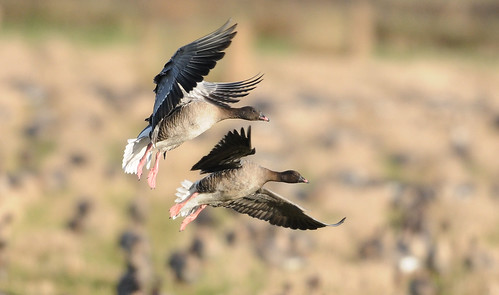Its good to have a first record of Spoonbill on the Lune Estuary, moving around a little but spending a lot of its time at the mouth of the River Conder, the bird has been in the area for a 'few' weeks now.
Thorburns Birds.
An excellent example of the Spoonbill, Flamingo, Black Stork, and White Stork from the equally excellent book 'Thorburns Birds'.
The Spoonbill breeds at scattered sites in Europe, it bred in East Anglia, probably until the 17th century. But the Spoonbill was seemingly extinct as a breeding bird until the late 1990's. Clifford Oakes mentions the first Lancashire record which is of a bird on the Ribble during 1840. More modern records show the first as being five birds at Ainsdale in 1958, with two birds in July 1963 at Leighton Moss RSPB Reserve where almost half the 'modern' records have been, and where the Spoonbill has been seen virtually annually since 1970.
By the late 1990's despite there being an increasing number of summering birds in the country there had never been any breeding Spoonbills suspected in the country, but a major surprise came in 1999 when a pair raised two young on the marshes of the south Ribble representing the first successful breeding in Britain since the 17th century....unfortunately they have not returned in subsequent years.
It is pleasing that I - like many other people - have seen the Spoonbill on recent visits to Glasson Dock where the bird can be viewed from the bowling green....an excellent record for the area.
Waving goodbye....

Pink-footed Geese Brian Rafferty
Waving goodbye....
Swallow Martin Jump
We've started to wave the Swallows goodbye for another year. I watched several individuals and groups fly past me going south last Friday with a mammoth task ahead of them. I reckon when we eventually see the records for 2012 we'll find the year has been at best a poor breeding season for the Swallows. One of the most amazing things about this species is that if the perch we see this individual on in this image is anywhere near its natal site, this bird could again be found on this very post next year....mind blowing facts.
Thanks Martin, a brilliant image of the young Swallow with a lot of flying to do and an unforgiving desert to cross to reach its wintering grounds in Africa.
Thanks Martin, a brilliant image of the young Swallow with a lot of flying to do and an unforgiving desert to cross to reach its wintering grounds in Africa.

Pink-footed Geese Brian Rafferty
And in a matter of a few weeks we'll be seeing the Pink-footed Geese dropping in in their thousands like these two to winter in areas like Pilling in the north Fylde.
And finally....
Peregrine Falcon Brian Rafferty
Yet another of those 'can't resist this one' images of an incredible Peregrine Falcon food pass with the adult above dropping prey to the juvenile below....Pretty impressive stuff Brian, thanks a lot for this and the PFG.



I love those Thornton paintings pete, Ive got them hung all round the house, only prints though :-)
ReplyDeleteExcelente captura la de los Halcones peregrinos pasandose la presa.Saludos
ReplyDeleteDidn't see it today Pete. Even braved the roadworks detour:-(
ReplyDeleteCheers
Davo
Warren.
ReplyDeleteThe 'Thorburns Birds' and 'Birds of Lancashire' by Clifford Oakes are my prize possessions, priceless to me.
Isidro.
BR will appreciate your comment on the Peregrine Falcon image.
Dave.
Not seen it mentioned for a couple of days now....sorry about your detour too.
amazing shots from Brian of the food pass!arsawr 57
ReplyDeleteIt amazes me to think of the journey these migratory birds go through and the instincts they have, we've all but lost our instincts! Great post, I must go and find that photo on Brian's blog and commend him for it - fabulous!
ReplyDeleteNice shots i have too an ornithology blog can u vsit please, am interested in your opinion http://joancabs.blogspot.com.es/
ReplyDeleteThanks Gary/Sharon/Joan.
ReplyDeleteI appreciate your visits and comments to Birds2blog, it goes a long way to my doing another post.